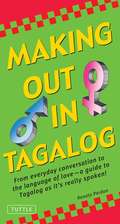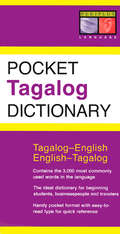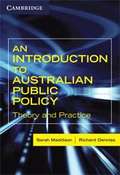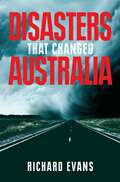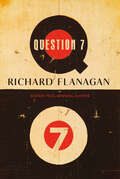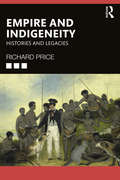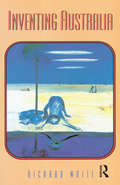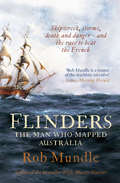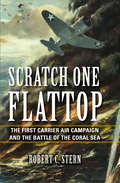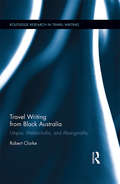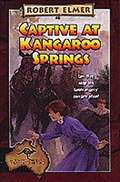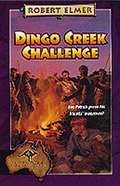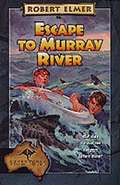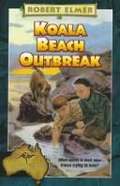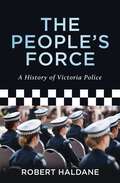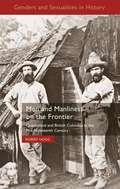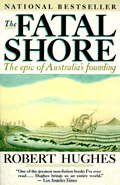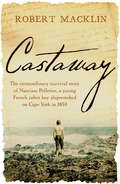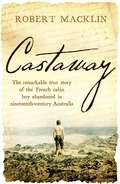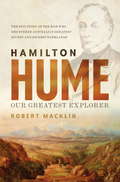- Table View
- List View
Making Out in Tagalog: (Tagalog Phrasebook)
by Renato PerdonMaking Out in Tagalog is a fun, accessible and thorough Tagalog phase book and guide to the Filipino language as it's really spoken.<P><P>If you are a student, businessman or tourist traveling to the Philippines and would like to have an authentic and meaningful experience, the key is being able to speak like a local. This friendly and easy-to-use Tagalog phrasebook makes this possible. Making Out in Tagalog has been carefully designed to act as a guide to modern colloquial Tagalog for use in everyday informal interactions-giving access to the sort of catchy Filipino expressions that aren't covered in traditional language materials. Each expression is given in Tagalog, so that in the case of difficulties the book can be shown to the person the user is trying to communicate with.This Tagalog phrasebook includes:A guide to pronouncing Tagalog words correctly including vowel combinations and stressing of wordsExplanations of basic Tagalog grammar, such as, word order, pronouns, borrowed words, and polite vs. impolite tensesUseful and interesting notes on Tagalog language and Filipino cultureLots of colorful, fun and useful expressions not covered in other phrasebooks
Pocket Tagalog Dictionary
by Renato PerdonThis is a pocket sized Tagalog (Filipino) DictionaryIntended for use by tourists, students, and business people traveling to The Philippines Pocket Tagalog Dictionary is an essential tool for communicating in Tagalog. It features all the essential Tagalog vocabulary appropriate for beginning to intermediate students. It's handy pocket format and easy-to read type will make any future trip to The Philippines much easier. In addition to being an excellent English to Tagalog dictionary and Tagalog to English dictionary Pocket Tagalog Dictionary contains important notes on the Tagalog language, Tagalog grammar and Tagalog pronunciation. All Filipino words are written in English and Tagalog so that in the case of difficulties the book can simply be shown to the person the user is trying to communicate with.This dictionary contains:The 3,000 most commonly used words in the Tagalog languageAn introduction to and history of the Tagalog languageInformation on Tagalog grammarA guide to pronouncing Tagalog correctlyOther books from this bestselling series you might enjoy are: Pocket Vietnamese Dictionary, Pocket Cambodian Dictionary, Pocket Thai Dictionary, Pocket Indonesian Dictionary, and Pocket Malay Dictionary.
Pocket Tagalog Dictionary
by Renato PerdonThis is a pocket sized Tagalog (Filipino) DictionaryIntended for use by tourists, students, and business people traveling to The Philippines Pocket Tagalog Dictionary is an essential tool for communicating in Tagalog. It features all the essential Tagalog vocabulary appropriate for beginning to intermediate students. It's handy pocket format and easy-to read type will make any future trip to The Philippines much easier. In addition to being an excellent English to Tagalog dictionary and Tagalog to English dictionary Pocket Tagalog Dictionary contains important notes on the Tagalog language, Tagalog grammar and Tagalog pronunciation. All Filipino words are written in English and Tagalog so that in the case of difficulties the book can simply be shown to the person the user is trying to communicate with.This dictionary contains:The 3,000 most commonly used words in the Tagalog languageAn introduction to and history of the Tagalog languageInformation on Tagalog grammarA guide to pronouncing Tagalog correctlyOther books from this bestselling series you might enjoy are: Pocket Vietnamese Dictionary, Pocket Cambodian Dictionary, Pocket Thai Dictionary, Pocket Indonesian Dictionary, and Pocket Malay Dictionary.
An Introduction To Australian Public Policy
by Sarah Maddison Richard DennissAn Introduction to Australian Public Policy: Theory and Practice is the first book to comprehensively address both the theoretical and practical aspects of policy making in Australia. Written in an accessible style, this text is designed to introduce students to the real world challenges and skills involved in working in a range of policy roles. Drawing on their own experiences, the authors ground public policy theory in a number of key controversies to illustrate the contestable nature of the policy process. Each chapter features case studies that outline contemporary policy issues, such as the deregulation of the financial system, 'Knowledge Nation', paid maternity leave, and the Northern Territory intervention. Including practical exercises on how to write policy briefs and media releases, this book is essential reading for anyone who needs to know how public policy is developed in Australia.
An Introduction to Australian Public Policy
by Sarah Maddison Richard DennissThe public policy arena is a complex framework of actors, politics and instruments. An Introduction to Australian Public Policy Second Edition examines the broad range of models, influences and players that shape the development of public policy in Australia, and equips students with a working knowledge of both the theoretical underpinnings and real-world challenges of the field. Fully revised and updated, the new edition addresses the diverse approaches to policy formulation required by different practitioners and institutions. Accessible and engaging, this edition includes: a new chapter on policy evaluation; practical exercises on how to write policy briefs and media releases and eleven new, concise case studies from Australia's top public policy practitioners. The book is accompanied by a companion website which contains chapter summaries and a glossary. Widely regarded as the best introduction to Australian public policy available, the book is an essential resource for undergraduate students of politics and policy workers.
An Introduction to Australian Public Policy
by Sarah Maddison Richard DennissAn Introduction to Australian Public Policy: Theory and Practice is the first book to comprehensively address both the theoretical and practical aspects of policy making in Australia. Written in an accessible style, this text is designed to introduce students to the real world challenges and skills involved in working in a range of policy roles. Drawing on their own experiences, the authors ground public policy theory in a number of key controversies to illustrate the contestable nature of the policy process. Each chapter features case studies that outline contemporary policy issues, such as the deregulation of the financial system, 'Knowledge Nation', paid maternity leave, and the Northern Territory intervention. Including practical exercises on how to write policy briefs and media releases, this book is essential reading for anyone who needs to know how public policy is developed in Australia.
Disasters That Changed Australia
by Richard EvansAustralian history is full of disasters. Some are natural but many more are man-made, results of individual or collective stupidity, reckless decisions, or greed. In Disasters that Changed Australia, Richard Evans nominates the worst disasters in an engrossing, insightful account of what happened and why. Picture British General, Douglas Haig through sheer arrogance and determination sending thousands of Australian men into swampy, disease-ridden enemy territory for no strategic gain. Or a feral legion of rabbits let loose on the environment, turning furry friends into an uncontrollable plague. Including Cyclone Tracy, Black Friday, the Snowy Mountains Scheme and the destruction of megafauna thousands of years ago, these are just many of debacles that have defined Australia. Richard Evans goes beneath the familiar stories and myths, and urges us to rethink how we respond to disasters to avoid making the same mistakes again.
Question 7
by Richard FlanaganAn exquisite, genre-defying new book from the Booker Prize–winning author of The Narrow Road to the Deep North, a reckoning with the author&’s life and family, and the role of fiction in our times"A spectacular mixture of fierce energy and then control, care. It is a kind of reckoning, Richard Flanagan with his father and his mother, Tasmania with its past, Japan with its past, the author with himself. It seems to me a book that will have an overwhelming effect on readers.&” —Colm Tóibín, author of Long IslandSometimes I wonder why we keep returning to beginnings—why we seek the single thread we might pull to unravel the tapestry we call our life...By way of H. G. Wells and Rebecca West&’s affair through 1930s nuclear physics to Flanagan's father working as a slave laborer near Hiroshima when the atom bomb is dropped, this daisy chain of events reaches fission when Flanagan as a young man finds himself trapped in a rapid on a wild river not knowing if he is to live or to die.At once a love song to his island home and to his parents, this hypnotic melding of dream, history, place and memory is about how our lives so often arise out of the stories of others and the stories we invent about ourselves.
Empire and Indigeneity: Histories and Legacies
by Richard PriceIndigeneity is inseparable from empire, and the way empire responds to the Indigenous presence is a key historical factor in shaping the flow of imperial history. This book is about the consequences of the encounter in the early nineteenth century between the British imperial presence and the First Peoples of what were to become Australia and New Zealand. However, the shape of social relations between Indigenous peoples and the forces of empire does not remain constant over time. The book tracks how the creation of empire in this part of the world possessed long-lasting legacies both for the settler colonies that emerged and for the wider history of British imperial culture.
Inventing Australia: Images And Identity, 1688-1980 (Australian Experience Ser. #No. 3)
by Richard White'White sets himself a most ambitious task, and he goes remarkably far to achieving his goals. Very few books tell so much about Australia, with elegance and concision, as does his' - Professor Michael Roe'Stimulating and informative. an antidote to the cultural cringe' - Canberra Times'To be Australian': what can that mean? Inventing Australia sets out to find the answers by tracing the images we have used to describe our land and our people - the convict hell, the workingman's paradise, the Bush legend, the 'typical' Australian from the shearer to the Bondi lifesaver, the land of opportunity, the small rich industrial country, the multicultural society.The book argues that these images, rather than describing an especially Australian reality, grow out of assumptions about nature, race, class, democracy, sex and empire, and are 'invented' to serve the interests of particular groups.There have been many books about Australia's national identity; this is the first to place the discussion within an historical context to explain how Australians' views of themselves change and why these views change in the way they do.
Labor'S Conflict
by Tom Bramble Rick KuhnOnce widely regarded as the workers greatest hope for a better world, the ALP today would rather project itself as a responsible manager of Australian capitalism. Labor's Conflict provides an insightful account of the transformations in the Party's policies, performance and structures since its formation. Seasoned political analysts, Tom Bramble and Rick Kuhn offer an incisive appraisal of the Party's successes and failures, betrayals and electoral triumphs in terms of its competing ties with bosses and workers. The early chapters outline diverse approaches to understanding the nature of the Party and then assess the ALP's evolution in response to major social upheavals and events, from the strikes of the 1890s, through two World Wars, the Great Depression, and the post-war boom. The records of the Whitlam, Hawke, Keating, Rudd and Gillard governments are then dissected in detail. The compelling conclusion offers alternatives to the Australian Labor Party, for those interested in progressive change.
Flinders: The Man Who Mapped Australia
by Rob MundleFLINDERS brings to life the fascinating story of this exceptional maritime explorer ? from the drama of epic voyages and devastating shipwrecks; his part in the naming of Australia; his cruel imprisonment by the French on Mauritius for six long and harrowing years; the heartbreaking separation from his beloved wife; and the comfort he got from his loyal cat, Trim; to his tragic death at just forty, before ever seeing the publication of his life's work. Flinders is a true hero whose name is forever woven into the fabric of Australian history. This is a gripping adventure biography in the style of the bestselling BLIGH: MASTER MARINER.
Scratch One Flattop: The First Carrier Air Campaign and the Battle of the Coral Sea (Twentieth-century Battles Ser.)
by Robert C. SternA study of the historic World War II naval battle, the first involving aircraft carriers and first in which neither warship was in sight of the other.By the beginning of May 1942, five months after the Pearl Harbor attack, the US Navy was ready to challenge the Japanese moves in the South Pacific. When the Japanese sent troops to New Guinea and the Solomon Islands, the Americans sent the carriers Lexington and Yorktown to counter the move, setting the stage for the Battle of the Coral Sea . . . In this book,historian Robert C. Stern analyzes the Battle of the Coral Sea, the first major fleet engagement where the warships were never in sight of each other. Unlike the Battle of Midway, the Battle of the Coral Sea has received remarkably little study. Stern covers not only the action of the ships and their air groups but also describes the impact of this pivotal engagement. His analysis looks at the short-term impact as well as the long-term implications, including the installation of inert gas fuel-system purging on all American aircraft carriers and the push to integrate sensor systems with fighter direction to better protect against enemy aircraft.The essential text on the first carrier air campaign, Scratch One Flattop is a landmark study on an overlooked battle in the first months of the United States’ engagement in World War II.“His research into sources on both sides is exhaustive and he has used Japanese translators where necessary and appropriate to best illuminate materials. His effort has taken years of meticulous scholarship and it shows. . . . Highly recommended.” —Lisle A. Rose, The Northern Mariner / Le marin du nord
Scratch One Flattop: The First Carrier Air Campaign and the Battle of the Coral Sea (Twentieth-century Battles Ser.)
by Robert C. SternA study of the historic World War II naval battle, the first involving aircraft carriers and first in which neither warship was in sight of the other.By the beginning of May 1942, five months after the Pearl Harbor attack, the US Navy was ready to challenge the Japanese moves in the South Pacific. When the Japanese sent troops to New Guinea and the Solomon Islands, the Americans sent the carriers Lexington and Yorktown to counter the move, setting the stage for the Battle of the Coral Sea . . . In this book,historian Robert C. Stern analyzes the Battle of the Coral Sea, the first major fleet engagement where the warships were never in sight of each other. Unlike the Battle of Midway, the Battle of the Coral Sea has received remarkably little study. Stern covers not only the action of the ships and their air groups but also describes the impact of this pivotal engagement. His analysis looks at the short-term impact as well as the long-term implications, including the installation of inert gas fuel-system purging on all American aircraft carriers and the push to integrate sensor systems with fighter direction to better protect against enemy aircraft.The essential text on the first carrier air campaign, Scratch One Flattop is a landmark study on an overlooked battle in the first months of the United States’ engagement in World War II.“His research into sources on both sides is exhaustive and he has used Japanese translators where necessary and appropriate to best illuminate materials. His effort has taken years of meticulous scholarship and it shows. . . . Highly recommended.” —Lisle A. Rose, The Northern Mariner / Le marin du nord
Travel Writing from Black Australia: Utopia, Melancholia, and Aboriginality (Routledge Research in Travel Writing)
by Robert ClarkeOver the past thirty years the Australian travel experience has been 'Aboriginalized'. Aboriginality has been appropriated to furnish the Australian nation with a unique and identifiable tourist brand. This is deeply ironic given the realities of life for many Aboriginal people in Australian society. On the one hand, Aboriginality in the form of artworks, literature, performances, landscapes, sport, and famous individuals is celebrated for the way it blends exoticism, mysticism, multiculturalism, nationalism, and reconciliation. On the other hand, in the media, cinema, and travel writing, Aboriginality in the form of the lived experiences of Aboriginal people has been exploited in the service of moral panic, patronized in the name of white benevolence, or simply ignored. For many travel writers, this irony - the clash between different regimes of valuing Aboriginality - is one of the great challenges to travelling in Australia. Travel Writing from Black Australia examines the ambivalence of contemporary travelers' engagements with Aboriginality. Concentrating on a period marked by the rise of discourses on Aboriginality championing indigenous empowerment, self-determination, and reconciliation, the author analyses how travel to Black Australia has become, for many travelers, a means of discovering 'new'--and potentially transformative--styles of interracial engagement.
Captive At Kangaroo Springs (Adventures Down Under #2)
by Robert ElmerBook 2 in the Adventures Down Under for middle-grade readers. Bushrangers take Patrick's sister hostage, then Patrick is captured. Can they find a way to stop the bounty hunters' terrible plan?
Dingo Creek Challenge (Adventures Down Under #4)
by Robert ElmerBook 4 in the Adventures Down Under series for middle-grade readers. Patrick and Becky find themselves in the middle of a dangerous confrontation between the town troublemakers and the local aborigines. Can they win the battle?
Escape to Murray River (Adventures Down Under #1)
by Robert ElmerBook 1 in the Adventures Down Under for middle-grade readers. Patrick McWaid's father is framed for a crime and sentenced to an Australian prison in the 1860s. But when their whole family arrives in Australia, Patrick's father has disappeared!
Koala Beach Outbreak (Adventures Down Under #7)
by Robert ElmerBook 7 in the Adventures Down Under series for middle-grade readers. The McWaids befriend Jasper, a young immigrant from China with an important secret. The prejudice of the town endangers the lives of the miners threatened with typhoid.
People's Force
by Robert HaldaneSince its formation in 1853 the story of the Victoria Police has been interwoven with Victorian social and political history. Following the amalgamation of seven separate and distinct police agencies in the colony, the resultant unified body was the first of its kind in Australia. Many events have shaped its development: the gold rushes, the Clunes riot, the Kelly outbreak, the maritime strikes, the coming of the motor car, the police strike, both world wars and the Vietnam war protests, the gangland wars, Black Saturday bushfires and the use of DNA to solve crimes all formed part of this mosaic. This revised edition of The People's Force, containing a new chapter and new illustrations, brings the history up to date to include a decade that has been full of turbulent change. The new chapter examines the administrations of Neil Comrie, Christine Nixon, Simon Overland, Ken Lay and Graham Ashton. New material deals with Silk and Miller, and other police shootings, the growth of terrorism, gender issues, racism and domestic violence. Written as a 'warts and all' history of the Victoria Police with the support and encouragement of the then Chief Commissioner S. I. ('Mick') Miller, who wanted a proper objective history of the force, not a public relations exercise. This third edition is owed largely to Miller's encouragement and his desire to see the history updated.
Men and Manliness on the Frontier
by Robert HoggIn mid-nineteenth-century Britain, there existed a dominant discourse on what it meant to be a man -denoted by the term 'manliness'. Based on the sociological work of R. W. Connell and others who argue that gender is performative, Robert Hogg asks how British men performed manliness on the colonial frontiers of Queensland and British Columbia.
The Fatal Shore: The epic of Australia's founding (Harvill Panther Ser.)
by Robert HughesThe history of the birth of Australia which came out of the suffereing and brutality of England's infamous convict transportation system. With 16 pages of illustrations and 3 maps.From the Trade Paperback edition.
Castaway: The extraordinary survival story of Narcisse Pelletier, a young French cabin boy shipwrecked on Cape York in 1858
by Robert MacklinIn 1858, 14-year-old Narcisse Pelletier sailed from Marseilles in the French trader Saint-Paul. With a cargo of Bordeaux wine, they stopped in Bombay, then Hong Kong, and from there they set sail with more than 300 Chinese prospectors bound for the goldfields of Ballarat and Bendigo. Around the eastern tip of New Guinea, however, the ship became engulfed in fog, struck reefs and ran aground. Scrambling aboard a longboat, the survivors undertook a perilous voyage, crossing almost 1000 kilometres of the Coral Sea before reaching the shores of the Daintree region in far north Queensland, where, abandoned by his shipmates and left for dead, Narcisse was rescued by the local Aboriginal people. For seventeen years he lived with them, growing to manhood and participating fully in their world - until in 1875 he was discovered by the crew of a pearling lugger and wrenched from his Aboriginal family. Taken back to his 'real' life in France, he became a lighthouse keeper, married and had another family, all the while dreaming of what he had left behind...Drawing from firsthand interviews with Narcisse after his return to France and other contemporary accounts of exploration and survival, and documenting the spread of European settlement in Queensland and the brutal frontier wars that followed, Robert Macklin weaves an unforgettable tale of a young man caught between two cultures in a time of transformation and upheaval.
Castaway: The remarkable true story of the French cabin boy abandoned in nineteenth-century Australia
by Robert Macklin'Macklin recounts, with beautiful detail, the following years of Narcisse's life and his transformation . . . a great read for anyone interested in Australia and its overlooked history'Ronan Breathnach, Irish Examiner 'A truly remarkable account drawing upon a version Pelletier gave when he eventually returned to his native France and also on anthropological studies of the Daintree people.' Piers Akerman, Daily Telegraph, Sydney 'An unforgettable tale of transformation and upheaval.'Stuart McLean, Daily Telegraph, SydneyA young boy abandoned in an alien landscape thousands of miles from home is adopted by local people and becomes one of them, welcomed into their community, marrying a wife and raising a child. After seventeen years, he is stolen back to his 'real' life, where he has another family, but dreams constantly of what he has left behind.This is the remarkable true story of a French cabin boy Narcisse Pelletier who, after disembarking from his ship the Saint-Paul with the rest of its crew in search of drinking water, found himself separated from his shipmates and in the end abandoned on the north coast of Queensland, Australia. Narcisse was adopted by an Aboriginal group who welcomed him as one of their own for seventeen years, during which time he had a family of his own. In 1875, though, he was kidnapped by the brig John Bell and was returned eventually to his family in Saint-Gilles, France, where he became a lighthouse keeper. Robert Macklin makes skilful use of Narcisse's own memoir Chez les sauvages along with new research to tell this extraordinary story.Robert is a Queenslander so knows the terrain and the people of the area in which Narcisse was left behind. Through Noel Pearson's Cape York Institute, he has arranged to meet descendants of the people who took the French cabin boy in and who know the stories of his time in Australia. Robert has also had access to a great deal of material on the early history of the Cape through the Australian National Library. He has drawn on the significant resources of the Australian Institute of Aboriginal and Torres Strait Islander Studies (AIATSIS) in Canberra on Aboriginal culture and history in Queensland and the Cape. In addition, he has made use of Narcisse Pelletier's own writings, including his account of his time in Australia, as well as several contemporaneous accounts of the Kennedy expedition to the area, including one from a member of the party. The author has made several trips to Cape York and one to Saint-Gilles and Saint-Nazaire in France.
Hamilton Hume: Our Greatest Explorer
by Robert MacklinThe untold story of Hamilton Hume - the Australian-born explorer who truly opened up the nation.While English-born soldiers, sailors and surveyors have claimed pride of place among the explorers of the young New South Wales colony, the real pathfinder was a genuine native-born Australian. Hamilton Hume, a man with a profound understanding of the Aboriginal people and an almost mystical relationship with the Australian bush, led settlers from the cramped surrounds of Sydney Town to the vast fertile country that would provide the wealth to found and sustain a new nation.Robert Macklin, author of the critically acclaimed Dark Paradise, tells the heroic tale of this young Australian man who outdid his English 'betters' by crossing the Blue Mountains, finding a land route from Sydney to Port Phillip and opening up western New South Wales. His contribution to the development of the colony was immense but downplayed in deference to explorers of British origin. Hamilton Hume uncovers this brave man's achievements and paints an intriguing and at times shocking portrait of colonial life, by the author of the bestselling SAS Sniper.
